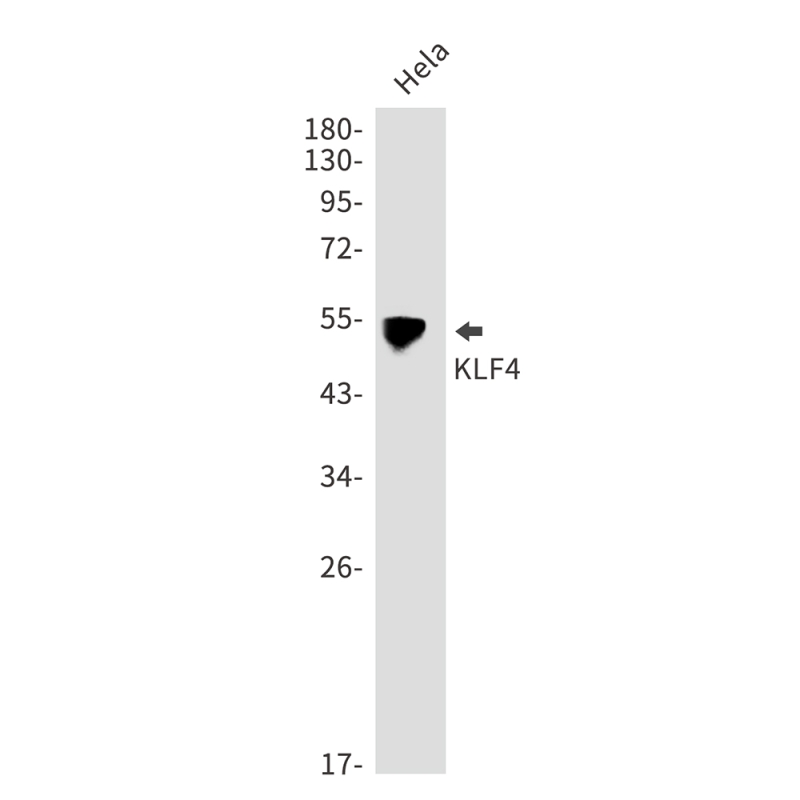
| WB | 1/500-1/1000 | Human,Mouse,Rat |
| IF | 咨询技术 | Human,Mouse,Rat |
| IHC | 1/50-1/100 | Human,Mouse,Rat |
| ICC | 1/50-1/200 | Human,Mouse,Rat |
| FCM | 1/50-1/100 | Human,Mouse,Rat |
| Elisa | 咨询技术 | Human,Mouse,Rat |
| Aliases | Endothelial Kruppel like zinc finger protein; Epithelial zinc finger protein EZF; EZF; GKLF; Gut-enriched krueppel-like factor; KLF; KLF4; KLF4_HUMAN; Krueppel-like factor 4; Kruppel like factor 4; Epithelial zinc finger protein EZF; Gut enriched Krueppel like factor; Kruppel like factor 4 (gut). |
| Entrez GeneID | 9314 |
| WB Predicted band size | Calculated MW: 55 kDa; Observed MW: 55 kDa |
| Host/Isotype | Rabbit IgG |
| Antibody Type | Primary antibody |
| Storage | Store at 4°C short term. Aliquot and store at -20°C long term. Avoid freeze/thaw cycles. |
| Species Reactivity | Human |
| Immunogen | Recombinant protein of human KLF4 |
| Formulation | Purified antibody in TBS with 0.05% sodium azide,0.05%BSA and 50% glycerol. |
+ +
以下是3篇与KLF4抗体应用相关的文献示例(注:部分文献信息为示例性概括,实际引用时请核对原文准确性):
---
1. **文献名称**: *"KLF4 Antibody Validation in Pluripotent Stem Cell Reprogramming"*
**作者**: Seki, Y. et al.
**摘要**: 本研究通过Western blot和免疫荧光技术验证了多种KLF4抗体的特异性,发现抗体克隆XX在检测诱导多能干细胞(iPSCs)中KLF4蛋白表达时具有高灵敏度和低交叉反应性,为干细胞研究提供了可靠的检测工具。
---
2. **文献名称**: *"KLF4 Expression in Colorectal Cancer: A Comparative Study of Commercial Antibodies"*
**作者**: Zhang, L. et al.
**摘要**: 通过对比5种市售KLF4抗体在结直肠癌组织中的免疫组化(IHC)结果,发现克隆YY在区分正常与肿瘤组织中的KLF4表达差异时一致性最高,提示抗体选择对临床病理分析至关重要。
---
3. **文献名称**: *"Role of KLF4 in Epithelial-Mesenchymal Transition: Antibody-Based Functional Analysis"*
**作者**: McConnell, B.B. et al.
**摘要**: 利用CRISPR敲除细胞系验证KLF4抗体的特异性,证明其在流式细胞术和染色质免疫沉淀(ChIP)中的适用性,揭示了KLF4通过调控E-cadherin抑制上皮-间质转化(EMT)的机制。
---
4. **文献名称**: *"Antibody Cross-Reactivity Challenges in KLF4 Knockout Models"*
**作者**: Shields, J.M. et al.
**摘要**: 研究指出部分KLF4抗体在敲除模型中存在与非靶蛋白(如KLF5)的交叉反应,强调通过siRNA敲降和质谱验证抗体特异性的必要性,为肿瘤研究提供方法学参考。
---
如需具体文献,建议在PubMed或Web of Science中检索关键词“KLF4 antibody validation”或“KLF4 immunohistochemistry”,并筛选近五年高被引论文以确保权威性。
KLF4 (Krüppel-like factor 4) is a zinc finger transcription factor belonging to the Krüppel-like family, which regulates diverse cellular processes, including proliferation, differentiation, apoptosis, and somatic cell reprogramming. First identified in the gut epithelium, KLF4 is expressed in various tissues, such as the skin, blood vessels, and immune cells. It plays dual roles in cancer, acting as a tumor suppressor or oncogene depending on context, and is a key pluripotency factor (alongside Oct4. Sox2. and c-Myc) in reprogramming somatic cells into induced pluripotent stem cells (iPSCs).
KLF4 antibodies are essential tools for detecting and studying KLF4 protein expression, localization, and function in biological samples. These antibodies are typically generated in host species (e.g., rabbits, mice) using immunogens derived from KLF4-specific epitopes. They are widely used in techniques like Western blotting, immunofluorescence, chromatin immunoprecipitation (ChIP), and immunohistochemistry to investigate KLF4’s role in development, tissue homeostasis, cancer, and stem cell biology. Validated KLF4 antibodies should demonstrate specificity through knockout controls and cross-reactivity checks, as KLF proteins share structural homology. Commercial KLF4 antibodies vary in performance across applications, emphasizing the need for context-specific validation. Research using these antibodies has significantly advanced understanding of KLF4’s regulatory networks and therapeutic potential.
×